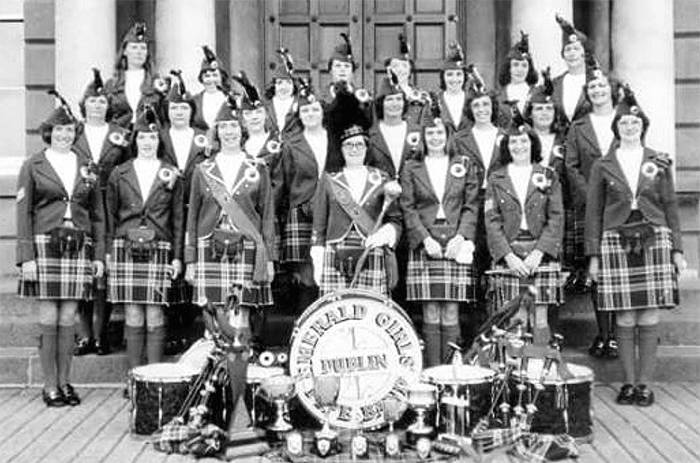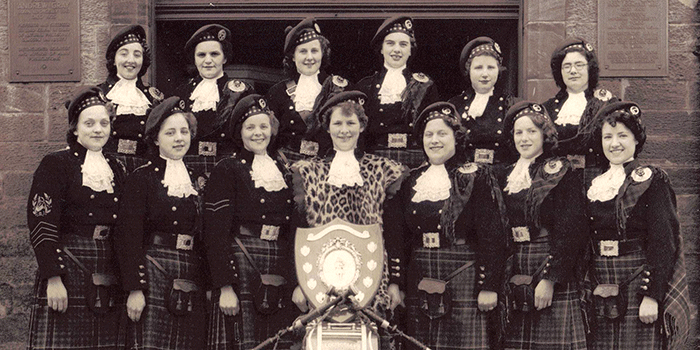
By Jeannie Campbell
Eleven members of the Caledonian Ladies under P/M Nan Stevenson played in Spain in 1956 and it was reported that the band had more overseas requets than they could cope with.
The Jean Carnie Girls from Edinburgh were competing in the Juvenile grade during 1956 and are pictured above in their very smart attire.
Helen Mallan, wife of the late Scottish singer Peter Mallan (‘For These Are My Mountains’), played in the band and her experiences were recorded in Pipe Band Magazine and will be published on PP later.
The Worlds that year were held in Belfast. The winners of the ladies’ grade, and the first non-Scottish band to win a World Championship, were the Emerald Girls from Dublin, playing the 8th Argyll and Sutherland Highlanders, Dorrator Bridge and Colonel Macleod.
The Caledonian Ladies from Bargeddie won the title at Paisley in 1957, with Maclean Ladies second and Lochgelly Ladies third. Another Irish band, the Faulat Girls from Belfast, visited Scotland in 1957.
The girls were all employed at the Faulat shirt factory in Belfast and their visit was arranged by Mr JA Faulkner OBE, President of the Northern Ireland branch of the SPBA, and owner of the Faulat factory. A feature of the band’s performance was their intricate maze and figure marching display.
The Caledonion Ladies won the Worlds title in 1957 with Jean Carnie Ladies in second place. P/M Anne Stevenson of the Caledonion Ladies featured on a Decca recording with entertainer Jimmy Logan made in the St Andrew’s Halls, Glasgow, that year. Several members of the band had played in Europe and travels even further afield were being planned.

In 1957 a photograph in the national press of a young lady tuning up at a band contest provoked a spate of uncomplimentary comments on female pipers.
An English correspondent wrote that playing the bagpipe made women look ugly and should be deprecated, but most of them became tired of it on reaching maturity when it was hoped they would ‘regain their feminine elegance’.
‘Arms too short to go round the bag, head cocked on one side, left shoulder at 45 degrees, and the blowpipe rammed into the throat. No wonder the result is an ear splitting din so unique as to be indescribable.
‘No wonder the simple Englishman looks on with bewilderment and awe and grudges not one penny of the amount he has paid to see this parody of a pipe band.
‘Many a phoney has got away with gulling an easily gullible public, but the girls’ pipe band has no superior in this so-called form of entertainment.’
Following this Heather MacKenzie, Pipe Major of the Nova Scotia Gaelic College Pipe Bond, was featured in the Piping Times.
Seumas MacNeill wrote that to mention lady pipers was a sure way to stir up trouble but that Heather was a better piper than nine out of ten of the die-hards who were always ready to snort their disapproval.
Sisters Olivia and Betty Wilson of Great Falls, Montana, USA, were serious about their piping and travelled by plane to Canada once a month for tuition from William Strachan in Calgary, Alberta. When on holiday in Scotland they visited their tutor’s old friend P/M Donald Macleod at Fort George.
In the late 1950s piper Jim Forbes left Dumbarton to start a new life at Quesnel on the Fraser River in Canada. He met another piper, Adam Smith, and together they taught some local boys and formed the Quesnel Legion Pipe Band which played all over the region.
One weekend they played at Williams Lake, a village at the foot of the Caribou Mountains and among the audience were nine Red Indian girls from the local Roman Catholic mission. They were fascinated and showed so much enthusiasm that Jim and Adam showed them the rudiments of piping there and then.
Some time later Jim received a letter from the Mission School. They had saved up a thousand dollars to buy bagpipes and would Jim teach the girls. Jim agreed and it was arranged that the girls would drive over from the mission every second weekend and spend three hours each day under tuition from Jim and Adam.
They turned out to be naturals and were soon able to play as a band. At the mission the nuns made tartan uniforms and Jim found himself in charge of the world’s first Red Indian Girls’ Pipe Band.

Lochgelly won the Ladies’ contest at Cowal in 1958, with Rose Fletcher Ladies in second place. Lochgelly Ladies were the winners again at the 1959 Worlds, with Maclean Ladies second and Aberdeen Ladies third. Lochgelly won the title again in 1960 at Inverness, with Bon Accord Ladies second and Maclean Ladies third.
In Canada at this time there were girls bands in Vancouver, Moose Jaw, Vernon and Medicine Hat. There had been a girls’ band in Calgary in the 1930s but this no longer existed.
In 1962 a group of interested parents and girls in Calgary got together. At first the new band was called Colonel Macleod Girls’ Pipe Band then in 1965 the Kinsmen Club became their sponsor, they were outfitted in Napier tartan and became known as the Kinsmen Brig O’Doon Girls’ Pipe Band.
The Blue Lake Ladies’ Pipe Band from Mount Gambier played at the 1959 Poinsettia Festival in Port Augusta and at Whyella, Quron and Port Pirie. Their performances were described as ‘outstanding’ and ‘magnificent’.
The South London Girl Pipers were listed among the new bands joining the SPBA in 1961. The Belfast Girls’ Pipe Band and the Faulat Girls’ Pipe Band were mentioned as playing at events in Northern Ireland that same year.
- To be concluded. Read the earlier instalments of this history here.

















Hi, my wife was in the Jean Carnie pipe band, and is in the photo at the top of the page. She can name most of the people in the photo if you are interested. She was stroke drummer, Agnes Cunningham. Laurence Black
Please forward the names Mr Laurence. RW
I was in the Blue Lake Ladies when we played at Port Augusta for the poinsettia festival wow it was my first trip away with the band…and was in the competition band when we won B grade and promoted after to A grade at Goulburn Australian championship. many great memories of a great band and our wonderful tutor Dickie Hepburn.